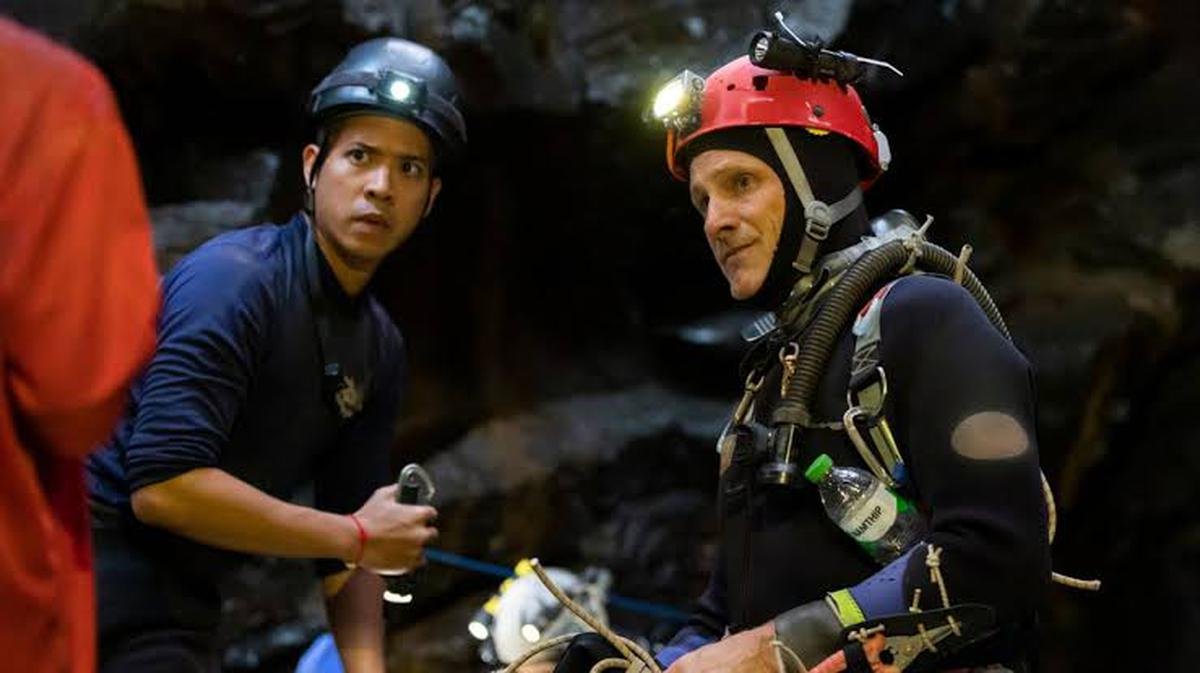‘Thirteen Lives’ Review: Ron Howard’s Best Film in Years
Thirteen Lives is Ron Howard’s most enthralling film in years, utilizing an impeccable cinematographer and terrific performances from its star studded cast to establish brilliant claustrophobic tension.
For those who have seen Tom Waller’s The Cave or Jimmy Chin and Elizabeth Chai Vasarhelyi’s The Rescue, Ron Howard’s latest, Thirteen Lives, might be a stale [and overlong] drama in comparison. However, the film is still a riveting exercise in tension. It's a well-written character drama centering around expert cave divers and Navy SEALs who worked together to perform an impossible rescue, saving a soccer team trapped in the Tham Luang cave in the Chiang Rai Province of Northern Thailand.
Cave divers Richard Stanton (Viggo Mortensen) and John Volanthen (Colin Farrell) travel to Chiang Rai after local Navy SEALs fail to locate the missing soccer team. After an almost six-hour, treacherous dive, the two find the soccer team but admit that bringing them back is nearly impossible. Stanton believes they will all die since none of them know how to swim in a cave, but Volanthen thinks something is worth trying. They enlist the help of Dr. Richard Harris (Joel Edgerton) to safely bring them out of the cave by sedating the children with ketamine for each diver to get them out of the cave.
In theory, none of it should have worked. But it did, and everyone involved in the Tham Luang cave rescue is now hailed as heroes, having saved every soccer team member trapped in the cave. But every child (and the coach) survives, and the film chronicles how the divers pulled off this impossible feat in a highly didactic way. At times, the pacing drags tremendously, especially during its latter half. There was no reason for Thirteen Lives to be almost two-and-a-half hours long, mainly when Howard shows multiple divers bringing each kid back, one by one, with little peril going on. Scenes of peril are intercut between non-eventful scenes, and they’re the highlight of the climax.
Knowing full well that everyone will get out alive (and unscathed) may dampen your enjoyment of these sequences, but when Jason Mallinson (Paul Gleeson) drops a needle underwater, and strong currents of water prevent him from reaching towards it, or when Chris Jewell (Tom Bateman) loses his line, Howard and legendary cinematographer Sayombhu Mukdeeprom creates effective, and claustrophobic tension to the point that we fear for the characters’ lives, even if the audience may know that everyone involved in the climax makes it out alive. Mukdeeprom is one of the greatest living cinematographers, and his work here ensures that this is Howard’s best-looking film yet. Underwater sequences are tight and well-executed, while scenes above water have lush neon colors, contrasting with the grey and torrential rain pouring over Tham Luang. It’s a shame the film had a limited theatrical release because Mukdeeprom’s work deserves to be seen on an IMAX screen.
The sound design from Michael Fentum also exacerbates the tension felt during the underwater scenes and beautifully complements Benjamin Wallfisch’s quiet but warped music, as characters go into the tightest possible spots to perform the impossible. The scraping of oxygen tanks or wetsuits as the water distorts the music has to be one of the best technical exercises of the year and a masterclass for anyone looking to establish tension and claustrophobia in a film. Perhaps it would’ve been more engrossing had no other film on the Tham Luang cave rescue come out before, but it’s terrifically executed nonetheless.
It would’ve been easy to turn Thirteen Lives into a ‘White-Savior’ narrative, mainly if it centered around Volanthen, Stanton, and Harris. But the film primarily focuses on the Thai family and Navy SEALs and gives their point of view first before the divers arrive to help them. In the movie, they never take credit for the feats they perform because the entire rescue is one significant team effort. Thai actors Sukollawat Kanaros, Sahajak Boonthanakit, and Vithaya Pansringarm deliver impeccable performances as Saman Kunan, Narongsak Osatanakorn, and Anupong Paochinda respectively, and give a point of view to the story that was barely touched upon in The Rescue.
Of course, Mortensen, Farrell, and Edgerton are terrific as Stanton, Volanthen, and Harris. They carry most of the film’s emotional pull, and there’s legitimate devastation in their eyes every time someone believes that none of the kids will make it out alive (including Stanton himself, who thinks the idea of sedating the children will not work). A supporting performance by Tom Bateman is also one of the film’s highlights, particularly during the scene where he loses his line. The reflection he gets afterward is the best performance the actor gave all year. Everyone is on their A-game, and Howard knows which characters to focus on so he can effectively establish suspense when they go underwater. The result is a surprisingly cathartic and claustrophobic experience that should be seen, even if you thought the other movies made on Tham Luang were terrific.
While Thirteen Lives isn’t perfect and could’ve had a good half-hour chopped down, the film remains a masterful exercise in tension building. It's also a brilliant showcase for Viggo Mortensen, Colin Farrell, Joel Edgerton, and Tom Bateman as some of the best Hollywood actors working today. Coupled with Sayombhu Mukdeeprom’s best-ever work as he crafts some of the most nerve-inducing underwater scenes in recent memory, you’ve got a highly effective survival drama. It’s Ron Howard’s best film since Rush, and one that hopefully brings the filmmaker back from making terrible films like Inferno, Solo, and Hillbilly Elegy to something as compelling and cinematic as Thirteen Lives. A true shame Amazon and MGM did not give this film the theatrical release it deserved.



